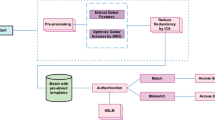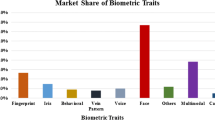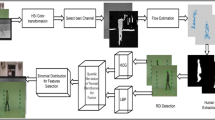Abstract
The unobtrusive nature of gait facilitates the development of optimal biometric authentication systems. Recent approaches on video-analytic gait authentication show excellent results but their implementations are threshold-based which trade off a set amount of FAR (false acceptance rate) to produce an acceptable FRR (false rejection rate). The proposed multiperson signature mapping (MSM) approach overcomes this drawback with a design that substantially decreases the FAR of the authentication system without having to increase the FRR. This technique removes the need of an empirically adjusted threshold. The state-of-the-art algorithms mostly prefer the nearest neighbor (NN) classifier where the Euclidean distance calculated from the extracted feature hyperplane is taken as the similarity measure. Our study proves that the Bayes’ rule applied over the extracted feature set provides a much better performance compared to the conventional NN approach. The MSM is applied on top of template-based gait recognition algorithms to produce an efficient gait authentication system. The method is evaluated on four different gait templates including the popular Gait Energy Image (GEI) and its variation with the genetic template segmentation (GTS). The study analyzes the performance across different clothing and carrying conditions. The deployment of the gait authentication system for practical application is explained in detail. Experimental results with the CASIA-B gait database depict the potential of our proposed approach.











Similar content being viewed by others
References
Dupuis, Y., Savatier, X., Vasseur, P. (2013). Feature subset selection applied to model-free gait recognition. Image and vision computing, 31(8), 580–591.
Liang, Y., Li, C.T., Guan, Y., Hu, Y. (2016). Gait recognition based on the golden ratio. EURASIP Journal on Image and Video Processing, 2016(1), 22.
Chattopadhyay, P., Sural, S., Mukherjee, J. (2015). Frontal gait recognition from occluded scenes. Pattern Recognition Letters, 63, 9–15.
Marín-Jiménez, M.J., Castro, F.M., Carmona-Poyato, Á., Guil, N. (2015). On how to improve tracklet-based gait recognition systems. Pattern Recognition Letters, 68, 103–110.
Ntantogian, C., Malliaros, S., Xenakis, C. (2015). Gaithashing: a two-factor authentication scheme based on gait features. Computers & Security, 52, 17–32.
Sarkar, S., Phillips, P.J., Liu, Z., Vega, I.R., Grother, P., Bowyer, K.W. (2005). The HumanID gait challenge problem: data sets, performance, and analysis. IEEE transactions on pattern analysis and machine intelligence, 27(2), 162–177.
Moustakas, K., Tzovaras, D., Stavropoulos, G. (2010). Gait recognition using geometric features and soft biometrics. IEEE Signal Processing Letters, 17(4), 367–370.
Medikonda, J., Madasu, H., Panigrahi, B. (2016). Information set based gait authentication system. Neurocomputing, 207, 1–14.
Han, J., & Bhanu, B. (2006). Individual recognition using gait energy image. IEEE Transactions on Pattern Analysis and Machine Intelligence, 28(2), 316–322.
Zhang, E., Zhao, Y., Xiong, W. (2010). Active energy image plus 2dlpp for gait recognition. Signal Processing, 90(7), 2295–2302.
Bashir, K., Xiang, T., Gong, S. (2010). Gait recognition without subject cooperation. Pattern Recognition Letters, 31(13), 2052–2060.
Choudhury, S.D., & Tjahjadi, T. (2015). Robust view-invariant multiscale gait recognition. Pattern Recognition, 48(3), 798–811.
Rida, I., Jiang, X., Marcialis, G.L. (2016). Human body part selection by group lasso of motion for model-free gait recognition. IEEE Signal Processing Letters, 23(1), 154–158.
Goldberg, D.E. (1989). Genetic algorithms in search, optimization and machine learning, 1st edn. Boston: Addison-Wesley Longman Publishing Co., Inc.
Isaac, E., Elias, S., Rajagopalan, S., Easwarakumar, K.S. (2017). View-invariant gait recognition through genetic template segmentation. IEEE Signal Processing Letters, 24(8), 1188–1192.
Arora, P., Hanmandlu, M., Srivastava, S. (2015). Gait based authentication using gait information image features. Pattern Recognition Letters, 68, 336–342.
Boulgouris, N.V., Plataniotis, K.N., Hatzinakos, D. (2006). Gait recognition using linear time normalization. Pattern Recognition, 39(5), 969–979.
Matovski, D.S., Nixon, M.S., Mahmoodi, S., Carter, J.N. (2012). The effect of time on gait recognition performance. IEEE Transactions on Information Forensics and Security, 7(2), 543–552.
Nakajima, H., Mitsugami, I., Yagi, Y. (2013). Depth-based gait feature representation. Information and Media Technologies, 8(4), 1085–1089.
Muramatsu, D., Makihara, Y., Iwama, H., Tanoue, T., Yagi, Y. (2013). Gait verification system for supporting criminal investigation. In: 2013 2nd IAPR Asian conference on pattern recognition (ACPR). IEEE, pp. 747–748.
Iwama, H., Muramatsu, D., Makihara, Y., Yagi, Y. (2013). Gait verification system for criminal investigation. Information and Media Technologies, 8(4), 1187–1199.
Jia, S., Wang, L., Li, X. (2015). View-invariant gait authentication based on silhouette contours analysis and view estimation. IEEE/CAA Journal of Automatica Sinica, 2(2), 226–232.
Jolliffe, I.T. (2002). Principal component analysis, 2nd edn. Berlin: Springer.
Duda, R.O., Hart, P.E., Stork, D.G. (2001). Pattern classification. 2nd Edition New York, pp. 55.
Hastie, T., Tibshirani, R., Friedman, J., Franklin, J. (2005). The elements of statistical learning: data mining, inference and prediction. The Mathematical Intelligencer, 27(2), 83–85.
Panda, D.K., & Meher, S. (2016). Detection of moving objects using fuzzy color difference histogram based background subtraction. IEEE Signal Processing Letters, 23(1), 45–49.
Rosebrock, A. (2016). Practical Python and OpenCV. pyimagesearch, Miami.
Dalal, N., & Triggs, B. (2005). Histograms of oriented gradients for human detection. In: CVPR 2005, IEEE, pp. 886–893.
Yu, S., Tan, D., Tan, T. (2006). A framework for evaluating the effect of view angle, clothing and carrying condition on gait recognition. In: 18th International Conference on Pattern Recognition (ICPR’06), IEEE, vol. 4, pp. 441–444.
Pedregosa, F., Varoquaux, G., Gramfort, A., Michel, V., Thirion, B., Grisel, O., Blondel, M., Prettenhofer, P., Weiss, R., Dubourg, V., Vanderplas, J., Passos, A., Cournapeau, D., Brucher, M., Perrot, M., Duchesnay, E. (2011). Scikit-learn: Machine learning in Python. Journal of Machine Learning Research, 12, 2825–2830.
Makihara, Y., Mannami, H., Tsuji, A., Hossain, M., Sugiura, K., Mori, A., Yagi, Y. (2012). The ou-isir gait database comprising the treadmill dataset. IPSJ Trans on Computer Vision and Applications, 4, 53–62.
Gafurov, D., Snekkenes, E., Bours, P. (2007). Spoof attacks on gait authentication system. IEEE Transactions on Information Forensics and Security, 2(3), 491–502.
Mjaaland, B.B., Bours, P., Gligoroski, D. (2010). Walk the walk: attacking gait biometrics by imitation. In: Proceedings of the 13th international conference on information security, Springer-Verlag, pp. 361–380.
Geradts, Z.J., Merlijn, M., de Groot, G., Bijhold, J. (2002). Use of gait parameters of persons in video surveillance systems. In: AeroSense 2002, international society for optics and Photonics, pp. 16–24.
Hadid, A., Ghahramani, M., Bustard, J., Nixon, M. (2013). Improving gait biometrics under spoofing attacks. In: International conference on image analysis and processing, Springer, pp. 1–10.
Acknowledgments
This work is supported by the Visvesvaraya PhD Scheme for Electronics and IT.
Author information
Authors and Affiliations
Corresponding author
Rights and permissions
About this article
Cite this article
Isaac, E.R.H.P., Elias, S., Rajagopalan, S. et al. Gait Verification System Through Multiperson Signature Matching for Unobtrusive Biometric Authentication. J Sign Process Syst 91, 147–161 (2019). https://doi.org/10.1007/s11265-018-1373-8
Received:
Revised:
Accepted:
Published:
Issue Date:
DOI: https://doi.org/10.1007/s11265-018-1373-8




